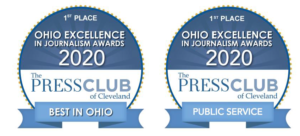Mark Chupp, a professor at Case Western Reserve University’s Mandel School of Applied Social Sciences and a FutureHeights board member moderated the forum. Chupp spoke about the importance of citizen participation in community decision making. He likened democracy to a three-legged stool that includes the public sector (local governments), the private sector (developers and private property owners), and civil society, which includes information sharing, civic dialogue and joint planning.
Panelist Terry Schwarz, director of Kent State University’s Cleveland Urban Design Collaborative, spoke about several important aspects to consider with any proposed development: job creation, income tax and property tax revenues, ecological impacts, and social impacts, such as providing choices for people who lack them.
Schwarz emphasized the need to understand supply and demand. “We are a declining city in a growing country. While Northeast Ohio is losing population, the United States will add 110 million people by 2050. But, we can change our response to the situation. We can position ourselves for recovery. Our proximity to the fresh water of Lake Erie is key,” she said.
“You must have a civic vision, a consensus community plan, or someone else will plan for you,” said panelist Hunter Morrison, director of the Northeast Ohio Sustainable Communities Consortium. “Citizens should insist on it well before they get to the point where there is a developer with a proposal; otherwise you’ll be in a reactive mode.”
Morrison emphasized the need to understand key trends, such as the fact that baby boomer retirees want to live close-in to take advantage of proximity to cultural attractions and that kids who grew up in cul-de-sacs now want cool places to live. “The Heights’s proximity to universities and hospitals is a magnet for talent. You are sandwiched between two growth engines, University Circle and I-271, and you need to compete successfully for doctors,” he said.
Morrison charged attendees to understand realities and then engage fully in becoming the third leg of the stool Chupp spoke about earlier. “Bad times are when you should plan,” he said. “Citizens must understand that, in Ohio, every municipality is required by law to balance its budget each year. We need joint community planning or municipalities will compete with each other.”
Ed Jerse, director of regional collaboration for Cuyahoga County Executive Ed Fitzgerald, suggested that the region is at a tipping point. “We can either succumb to bad news or work for positive change,” he said. “The promise of regionalism is that we stop competing against each other and start working together. That begins with planning on a more regional basis.” He said that Ed Fitzgerald’s new $100 million economic development fund could be used to finance studies to help communities understand the benefits of collaboration and create a playbook that would help them do so.
Attendees wrote comments about what they found new or surprising about the panelists’ comments and identified questions on index cards, which were then collected and presented to the panelists.
View video of the presenters and questions and comments from the audience on the forum. Then have your say.
WATCH VIDEO HERE: http://vimeo.com/22292892



Mitch Schneider would have been very proud of The Terry Schwarz Twist..or was it a Tango. What a snow job, a con, a contrived load of babble, an inside job, a set up disguised as a community forum. Who’s paying her? CH and SE residents, the third leg of the stool, don’t let the developer and muni-enablers hoodwink you. The entrenched incumbents, their appointed yes men, developers with dollar signs in the short sighted beady little eyes and, of course, a corrupt county network has finally come to roost on old Oakwood Country Club. The fools want a Big-Box with Severence Mall on one side and the dirt pile that is Cedar Center on the other. Now Schneider and his investors might try to bail SE Officials out of the Cedar Center mess in return for allowing him to pave over Oakwood. DEVELOPE CEDAR CENTER AND LEAVE OAKWOOD ALONE FOR THE TIME BEING. If we don’t come up with a green alternate plan by the time Cedar Center is completed then go right ahead and put in the BIG-BOX at Oakwood.